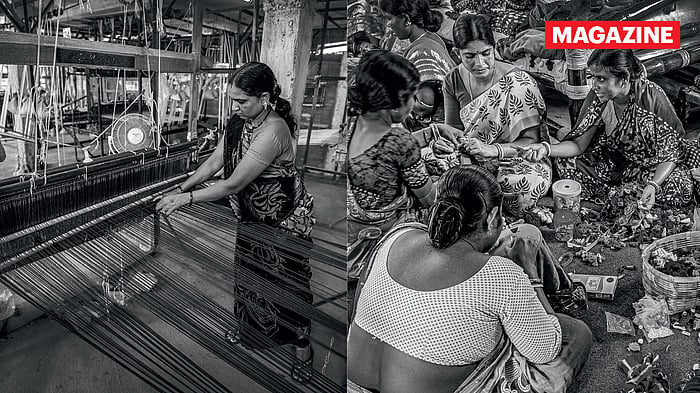“There are artisans who have gone from one loom to five,” says Rai. “Currently, there are 2% people in the craft ecosystem whom we can call entrepreneurs… our target is to increase the number to 20%. Only then, there will be more parity and less distinction in the pay bands of people.”
According to Ajaita Shah, founder & CEO of Frontier Markets, a social commerce rural supply-chain platform manned by rural women (sahelis), the access gap can only be fulfilled if one understands how to truly localise the market. “In a village, a person should not have to walk more than 15 minutes, or 500 metres, to get everything they need… But the only way you would understand what those things would be is if there are women at the centre using technology and asking the right questions.”
Frontier Markets focusses on meeting the right social innovators, judging their quality of products, conducting tests to see whether or not the products are relevant, and evaluating whether there is a value proposition. The company is looking to go from 1 million to 100 million sahelis in less than five years. “We help corporates identify the right customer base. It’s an impact story that both India Inc. and the government need. In fact, states are our biggest partners. We recently signed an MoU with the Andhra Pradesh government, and we already have those in place with Uttar Pradesh and Rajasthan governments.”
It’s not restricted to India. “Countries, including Ethiopia, Nigeria, Kenya, and Myanmar, want to replicate what we do,” adds Shah.
Challenges galore
One of the biggest challenges is scaling up these businesses. Lack of digital literacy, limited access to global markets, and the absence of proper infrastructure often create problems.
“The dispersed nature of the value chain, from yarn to handloom weavers, to tailors and hand embroidery artisans, spread across the country, makes for a logistical challenge. The introduction of GST further increases complexity as raw materials and goods are moved from one state to another. Production tracking and maintaining quality standards in different locations are also key issues,” says Sumita Ghose, founder-director of artisans’ collective Rangsutra Crafts India.
Raising funds is another huge challenge. While angel investments of around ₹50,000-1 lakh are available, venture capitalists are less likely to invest in the sector. Large-scale funds typically flow into microfinance institutions (MFIs), leaving a funding gap for small-scale businesses.
“A small-scale handloom weaver needs to buy yarn, rent a loom. The average interest charged on micro-credit at the rural level is 20-22%. So, access to working capital is a big issue,” says Divya Sampath, venture capital investor (AWE Funds) and innovation advisor, Aspire For Her. She cites the example of Jyoti (name changed) who runs a small kirana store and an attached flour mill in a village in Andhra Pradesh. Four villages in the surrounding area bring their millets, wheat and other products, and she grinds them for a price. During the harvest season, she keeps it closed every alternate day for her employees and herself to work in the fields. She gets a guaranteed ₹400-500 for working seven hours in the field, against the uncertainty of products being sold at the store.
“In rural areas, the line between entrepreneurs and wage earners is very thin, and people cross back and forth over it regularly,” says Sampath. “Moreover, more often than not, women are seen as incapable of managing businesses, a bias reinforced by family and community expectations.”
Shah of Frontier Markets says that the challenges are around: i) how active the platform is; ii) how consistent the job opportunity will be; and iii) how much these micro entrepreneurs are earning to make it a sustainable proposition for the long term. “Identifying the right talent, deciding the right product-market fit, training them, building market opportunity and creating consistency are important… Our learning is that one needs to be ‘multi-service’. Otherwise, there won’t be enough money in it for the women to earn, especially as a full-time job,” she explains.
Padaki of GAME suggests a fund of funds by the government and a digital co-operative that will help integrate multiple aggregators under a common platform will help. “It’s a chicken-and-egg situation. You have to be local as far as your supplies are concerned, but to command a better market you have to go global,” he says.
Women-led aggregators are empowering artisans, fostering entrepreneurship, and bridging gaps in the market, creating sustainable livelihoods. As Ghose of Rangsutra puts it, “Women need to show the world that there are ways of doing business that can benefit all along the value chain they work in, and not just the select few at the top. This will make for a more equitable, sustainable, and resilient economy and society.”
Source:https://www.fortuneindia.com/long-reads/the-aggregator-advantage-empowering-rural-india-against-all-odds/121710

